What you’ll learn
We all know the slogan from the world-famous energy drink: “Red Bull gives you wings.” But what gives Red Bull its wings to reach millions of people and generate billions of dollars each year? Brand messaging plays a huge role.
It’s why people recognize and respect Red Bull’s place in their industry, even if they don’t drink their product.
How can you achieve this same caliber of instant brand-recognition? With bulletproof a brand messaging framework.
We chatted with Lyon Content founder and branding badass Christina Lyon about the key elements of a brand messaging framework, including brand messaging examples, audience impact, and more.
Mixed messages? Not with this framework in your marketing toolkit.

What Is a Brand Messaging Framework?
A brand messaging framework is a tactical document with detailed instructions around effective brand communication, including content types, formats, tone of voice, word choices, and more to showcase your brand’s selling points within your content.
In other words? It’s a how-to guide for standing out from your competitors.
You might think getting up to speed on the latest research and trends would be effective ways to stand out—but that’s still not enough.
A brand messaging framework is what differentiates your brand from all the others in your niche. This foundational element infuses all your content efforts and marketing campaigns with your brand story and values.
Why Is Brand Messaging Important?
Brand messaging is the way you truly connect with your audience. It hammers home the message you want people to associate with your brand every time they interact with your content. The result? Brand awareness, recognition, and customer trust—which all bring you more sales down the line.
Trust us, we’ve seen the consequences of content created without solid brand communication strategies. It doesn’t convert as well because it can attract the wrong audiences to your biz.
Conversely, in a study by LucidPress, 32% of brands said consistent brand messaging increased revenue by more than 20%.
And that’s why it’s vital to have a solid brand messaging framework.
5 Steps to Create a Successful Brand Messaging Framework
Coming up with a brand message sounds easy, right? Not so much.
Even if you know your brand inside and out, your messaging strategy won’t be clear right away. Let’s flesh it out with Lyon Content’s proven five-step process for creating a brand messaging framework.
Step 1: Create a Brand Positioning Statement
A brand positioning statement is a short explanation of how your brand helps your audience. Think of what your business offers in the simplest yet striking terms possible—that’s a solid place to start. Here’s an example from Lyon Content:
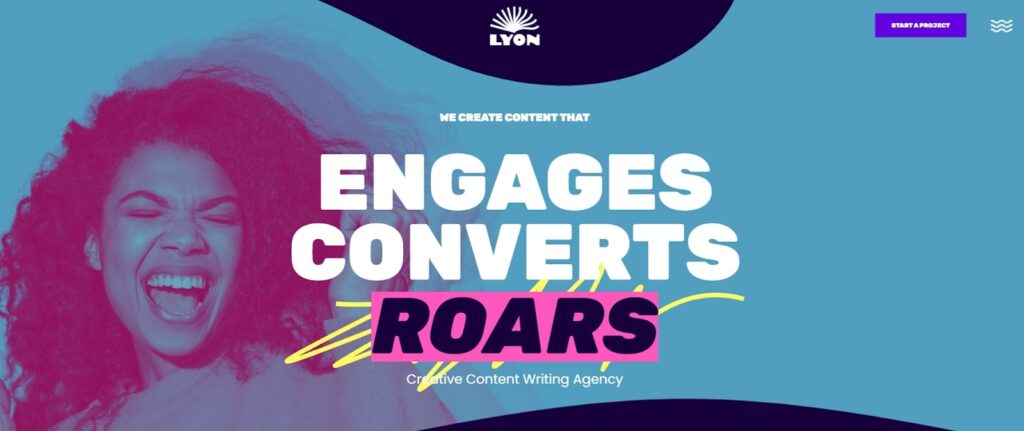
Of course, you can also make your brand positioning statement more beefy. Here’s another example from Nike:
“For athletes in need of high-quality, fashionable athletic wear, Nike offers customers top-performing sports apparel and shoes made of the highest quality materials.”
Our take? Nike’s example identifies their products and services, but they could say it in fewer words (and less repetition).

We like to get to the point, and we believe audiences appreciate it, too.
You can easily create your brand positioning statement right now. Here’s the formula:
- Write down your offering (product/service)
- Then add who you help (your target audience)
- Lastly, briefly sum up what makes you unique
Say you sell natural beauty products for women over 40. Using the instructions above, you could come up with something like this:
“We scientifically formulate natural skincare products using the purest ingredients to help women over 40 age gracefully and safely.”
Step 2: Conduct Competitive Analysis
Research what your competitors say and how they say it. Competitive analysis should highlight 5-10 niche competitors and list out brand messaging elements for each one in a clear chart.
Here’s a sneak peak at Lyon Content’s competitor chart:
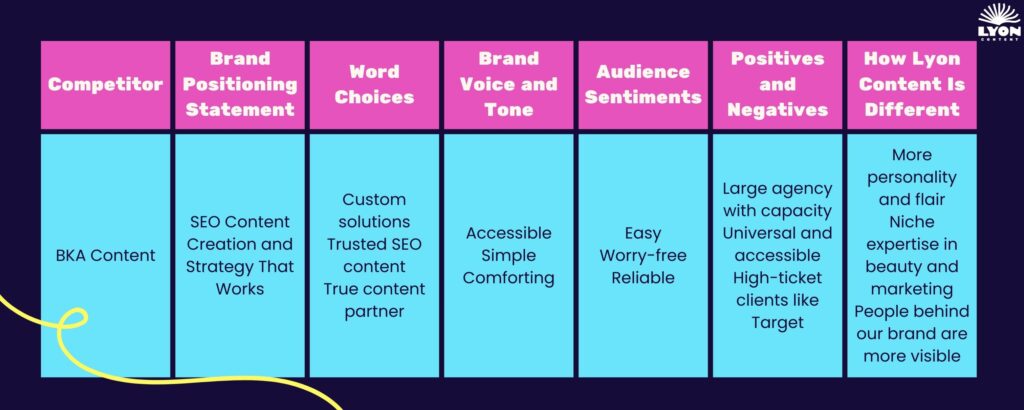
You can find the essential data on competitor social media profiles, news releases, quotes in publications, and videos of reps at speaking events.
Now, where does the analysis come in? What do you do with all this info? Let’s start with what NOT to do: copy your competitors.
Even if they’re killing it with social media engagement and traffic, you still need to make sure you can one-up them with something different.
Christina shares an example:
“We look at competitors to see how they’re communicating with their audience. For example, for a recent brand messaging project for a novelty food supplier, we scoured their competitors’ blogs and realized that everyone was focusing primarily on the tech and science aspect, and the language came across as inaccessible jargon.”
So, what do you do when you notice a competitor branding element that you don’t like? Christina sees this as an opportunity to differentiate your brand:
“We focused on the rich origin and heritage of our client’s multi-generational business, and by emphasizing their legacy and family values, we humanized the brand in a way that makes them more warm and appealing than their competitors.”
Now that you have a framework on paper, you’re ready to implement it in all of your pieces of content. But how can you tell if it’s working?
Step 3: Build Your Brand Voice
Brand voice reflects your brand identity, personality and values in every piece of content. It’s the voice that carries your brand message to your target audience and remains constant, whether you’re writing an email newsletter or blog post.
Here are some elements to consider in your brand voice:
- Branded vs. non-branded language: Branded language is sometimes trademarked, such as short phrases that include your brand’s name. For example, “Content that Roars” is a branded phrase for Lyon Content. Non-branded terms are broader, more competitive keywords that readers can comfortably associate with your brand but also competitors. An example for Lyon Content would be “beauty brand content writing.”
- Emotional resonance: How do you want your audience to feel when you speak to them? Inspired? Comforted? Excited? Confident? All these feelings determine the emotional resonance of your brand voice.
- Readability: Most Americans read at an eighth-grade level, but more niche audiences could be used to lower- or higher-reading-level content. Consider readability and only waver from the norm if you have the right audience insights to back it up.
Once you have an idea of how you want to sound? Set yourself up for success with voice guidelines.

Step 4: Create Voice and Tone Style Guides
Brand voice speaks to your brand’s personality and values, while tone of voice speaks to your audience’s needs. We talk more about these concepts in our How to Find Your Brand Tone of Voice article, which covers:
- The difference between tone and voice
- How audience and brand values inform tone and voice
- How to reflect your competitive advantage in your brand’s tone of voice
We highly recommend reading our comprehensive breakdown because brand voice and tone of voice are vital components of your brand messaging framework. After all, how you deliver the message is often just as important as the message itself.
Step 5: Monitor, Test, and Tweak Your Brand Messaging
No matter how much time you put into your brand messaging framework, you can’t be 100% certain it will meet your content goals. Even experts like Lyon Content’s talented writers, content creators, and brand strategists always look for opportunities to improve a brand messaging framework.
Christina points out a few signs that your brand messaging framework is working:
- ✅ Social media engagement (including post sharing, comments, and conversations with your audience)
- ✅ Web traffic increase
- ✅ Email newsletter subscriptions
She also shares a few red flags that indicate it’s time to revisit and refine your brand messaging:
- ❌ Crickets on your social media profiles
- ❌ Negative interactions and comments from your audience
- ❌ Stagnant web traffic
If you see any of these red flags? It’s time to rethink your strategy.

5 Reasons Your Brand Messaging Framework Isn’t Working
Here are some of the most common culprits of ineffective brand messaging frameworks that Christina has seen:
- Not investing in your brand messaging in the first place: “With enough audience data and research, the messaging should align with their needs.”
- Hyperfocusing on your needs vs. your audience’s: “[Negative results] can happen by sending out a message based solely on YOUR idea of what your customer wants.”
- Rushing your brand messaging framework: “It can take about 2-3 weeks, but it’s not a process you want to rush. You need adequate time to look at your competitors, scroll through social media comments, discussion forums, existing audience data and analytics, and interview sources.”
- Neglecting some content marketing and media channels: “[This entails] using your brand messaging framework for only one platform (blog) and not others (social, newsletter, etc.)”
- Guessing at language and tone: “Always start with research. Gather pertinent data about your existing audience and target clientele. Use that data to inform the language and tone.”
So how do you avoid these common missteps? Inform your brainstorming sessions with examples of engaging, converting brand messaging from our clients.
The Best Examples of Brand Messaging
All our clients have one thing in common: they have a bold, valuable message to deliver to their audience. But we’ve had to tweak that delivery method depending on each brand’s unique values, vibe, and audience.

Let’s look at some examples.
Example 1: Communicating Confidence and Luxury for MD GLAM
Luxury skincare brand MD GLAM has a wide audience of women between the ages of 20-65—we know, it’s vast! But despite the age variety, every single one of their readers all found comfort in brand messaging that offered two things:
- Confidence: MD Glam’s competitors (and anti-aging skincare brands in general) often make false promises and offer questionable results. So we wanted to make sure their readers could see their authority from the first sentence by including confident brand messaging throughout their web copy. “Science-backed,” “results-driven,” and “dream team” are some example phrases that instill customer loyalty and confidence.
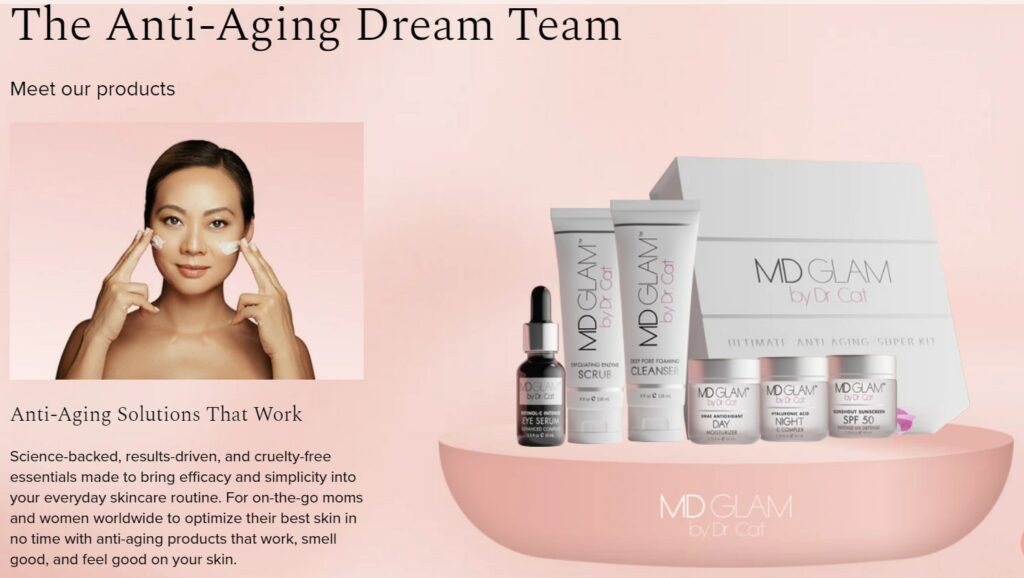
- Luxury: Photos are great for reinforcing your brand messaging framework. They add to the overall vibe you want your audience to feel. This blog article we wrote uses relatable copy that helps readers feel beautiful and pampered.
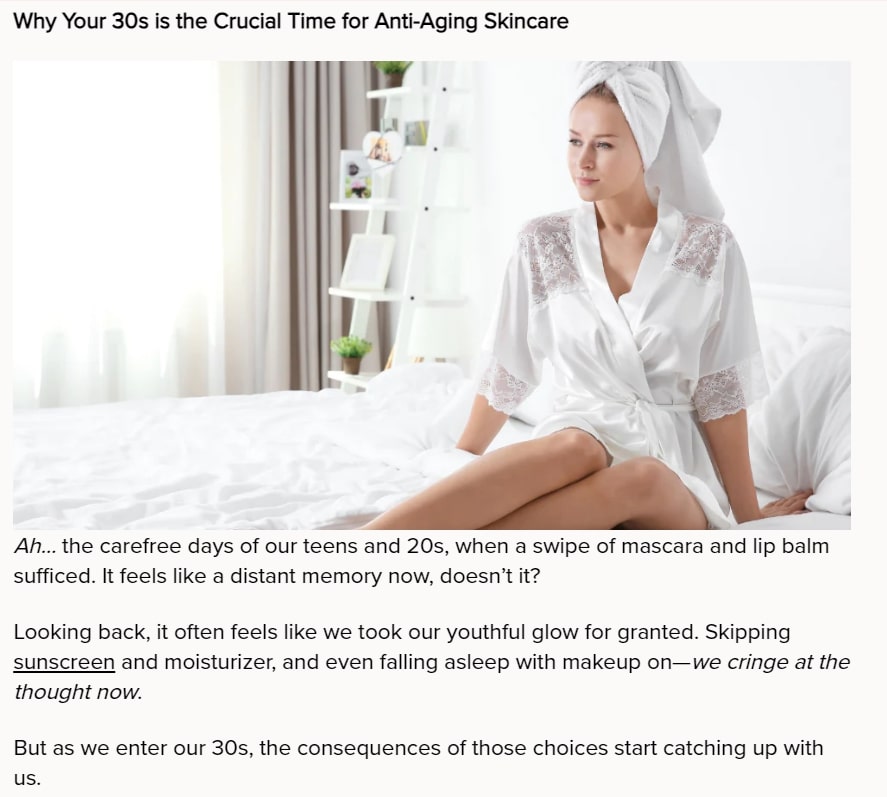
Now, does every brand need to include the same confident and luxurious vibe in their brand messaging framework? It all depends on their audience!
Example 2: Educational and Rebellious Tone for Rainbow King Food’s Niche Farmed Fish Market
Rainbow King Foods (RKF) is a bold, regenerative farmed fish brand based in Wisconsin. But they’re also Viking-themed. And need to come off as more trustworthy than their wild-caught fish competition often assumed to be better quality. Needless to say, they had a lot going on when they came to us for help.
We fleshed out two main audience personas for them: the retired, well-to-do suburban couple interested in quality above all else and the modern single hipster passionate about sustainability.
From there, it became easier to create a brand messaging framework with special attention to educating readers about RKF’s sustainable approach under the umbrella of a strong, Viking attitude that propelled their rebellious yet playful brand voice.
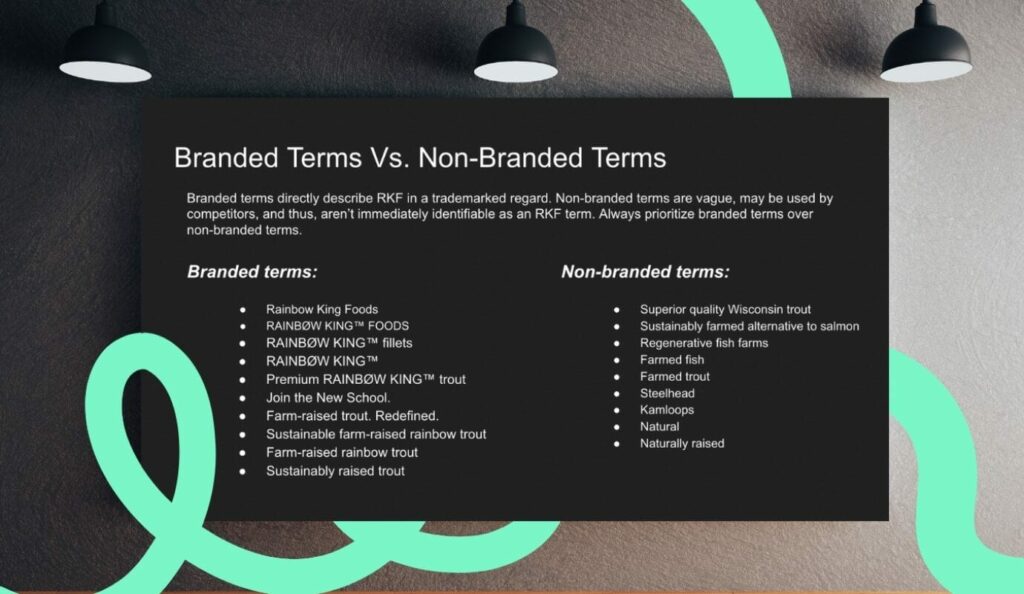
Example 3: The “Skincare Bestie” for embody
Edible skincare brand embody had a solid set of brand voice guidelines that catered to busy Millennial babes that need a break from the hustle culture and 12-step influencer skincare routines.
Our job? Communicate embody’s unique selling propositions (USPs) of convenient, effective, and innovative skincare in their established voice in every sentence.
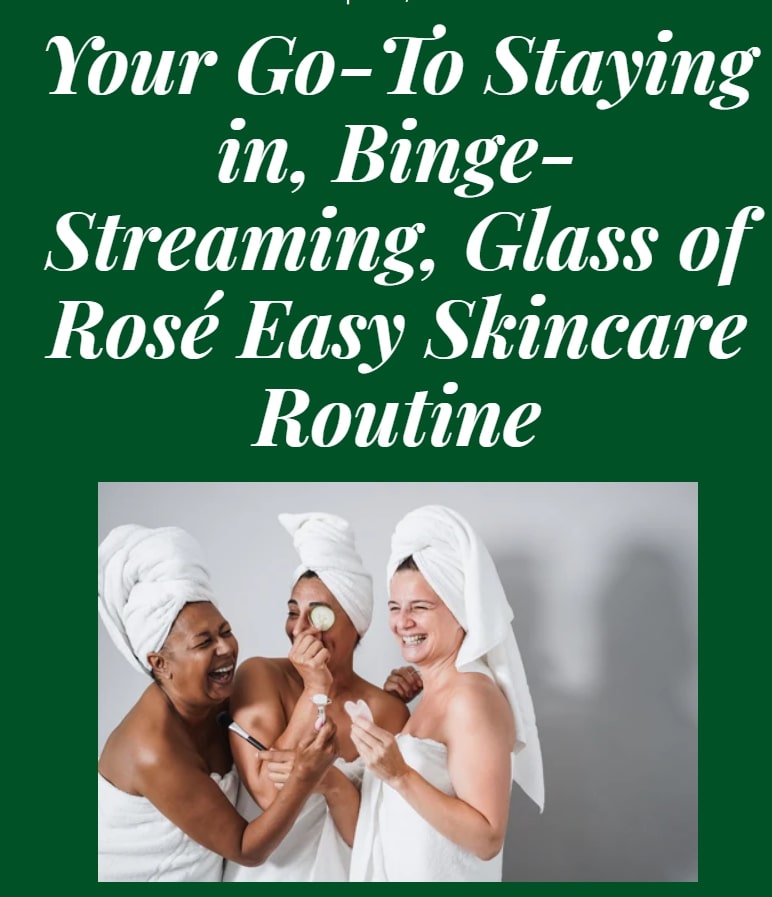
But the best way to give your brand messaging framework the highest possible chance of conversion? Call on the pros.
Our talented writers and branding experts have the time, knowledge, and skills to really dissect your product USPs, business goals, and audience characteristics to craft voice, tone, and brand messaging guidelines that hit home with every sentence. Start a brand messaging project with Lyon Content!
Brand Messaging Framework: A Complete Checklist
Ready to pen your brand messaging framework into a tangible, usable document that streamlines all your content? Compile all your research, and use this framework for easy reference.
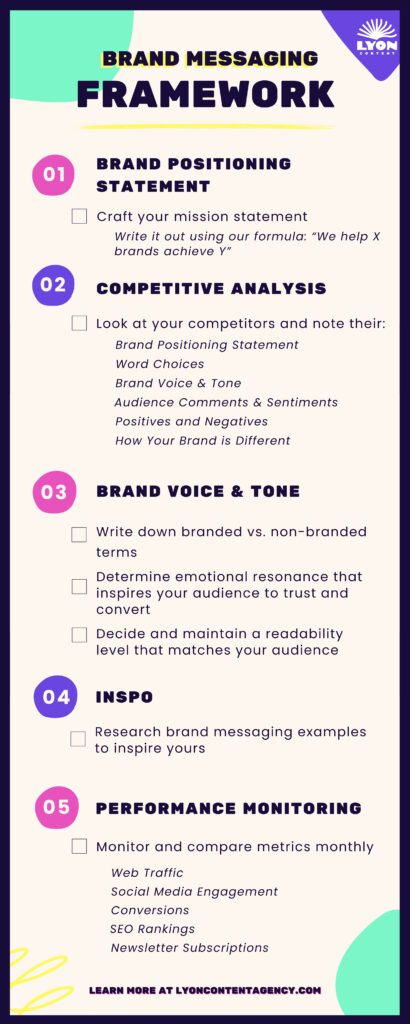
Build a Bangin’ Brand Messaging Framework with Lyon Content
If you want to connect with your audience, stand out from competitors, and feel 100% confident in your brand’s online presence, then you need a kickass brand messaging framework to unite your content under the values and energy you want to deliver to your audience.
But even with a thorough tactical guide like this one, compiling extensive research into an objective, goal-oriented framework isn’t easy.
Plus, you’ll always feel a little too close to your brand to see it objectively. Christina says that’s where Lyon Content steps up:
“Using the language and common threads we find in your audience and competitor data, we craft a compelling narrative built around your audience’s needs. We interview every client’s key players, do in-depth research and background, and then build the brand messaging. As a busy biz owner or marketer, you’re often simply too invested to remain objective, which is why it’s great to partner with a pro you trust.”
It’s time to give your content—and your audience—the TLC they deserve.
Let’s team up to build a brand messaging framework that compels your audience to stop scrolling and take action!

09/27/2023
Chrissy is a contributing writer at Lyon Content based in Toronto. She loves writing and editing tech, marketing, and lifestyle content. But her favorite part of writing is helping businesses express themselves. When she isn't writing, she's traveling as much as possible and eating a lot of cheese.





